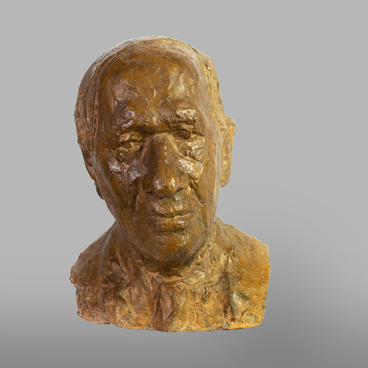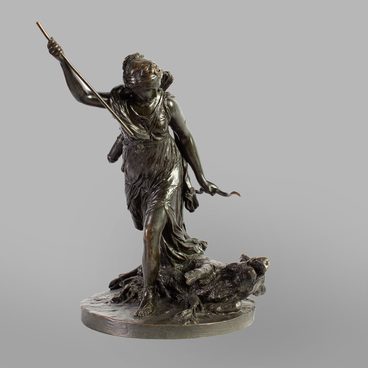The bas-relief “Pitti Tondo” from the collection of the Tambov Regional Art Gallery is a copy of the work of the great Italian Renaissance master Michelangelo Buonarroti. The bas-relief is made in the form of a tondo — a term for a circular work of art. It is known that Michelangelo created the Pitti Tondo relief between 1505 and 1508 for Bartolomeo Pitti, and then the work was kept in the Guicciardini family. The masterpiece is currently housed in the National Museum in Florence.
Despite the attributes of genre painting present in the scene, Michelangelo’s image of the Madonna is full of grandeur and inner strength. The unknown sculptor, who created the copy on display, meticulously conveyed all the details of the original relief, reflecting not only the images created by Michelangelo but also the stone processing techniques that the master used. The bas-relief combines smooth polished surfaces and unpolished ones, with clearly visible traces of chiseling, giving the work both an unfinished character and a sense of the transience of life.
The very fact that the unknown sculptor turned to the work of Michelangelo speaks volumes. This shows that Renaissance art enjoyed a surge of interest in the mid-19th century, which, to a certain extent, ran counter to the fascination with antiquity. A number of Italian sculptors, including Lorenzo Bartolini, viewed Renaissance art as the national heritage and were guided by it. The forgeries of Giovanni Bastianini, who was eager to discover hitherto unknown creations of Renaissance masters, were quite timely. The sculptor, who created the copy of the Pitti Tondo relief, seemed to have a more unassuming motive in mind — he copied the original to make it available to those who were fond of it.
Little is known about the history of the presented bas-relief. The piece once belonged to Leonid Voyeikov. Using the documents found in the Tambov archives, the art critic Yekaterina Salyakhova managed to establish that the bas-relief entered the Art and Science Museum in 1926 or 1927. “Pitti Tondo” was housed in the Tambov Museum of Local Lore until 1961 when it became part of the newly formed Tambov Art Gallery.
Despite the attributes of genre painting present in the scene, Michelangelo’s image of the Madonna is full of grandeur and inner strength. The unknown sculptor, who created the copy on display, meticulously conveyed all the details of the original relief, reflecting not only the images created by Michelangelo but also the stone processing techniques that the master used. The bas-relief combines smooth polished surfaces and unpolished ones, with clearly visible traces of chiseling, giving the work both an unfinished character and a sense of the transience of life.
The very fact that the unknown sculptor turned to the work of Michelangelo speaks volumes. This shows that Renaissance art enjoyed a surge of interest in the mid-19th century, which, to a certain extent, ran counter to the fascination with antiquity. A number of Italian sculptors, including Lorenzo Bartolini, viewed Renaissance art as the national heritage and were guided by it. The forgeries of Giovanni Bastianini, who was eager to discover hitherto unknown creations of Renaissance masters, were quite timely. The sculptor, who created the copy of the Pitti Tondo relief, seemed to have a more unassuming motive in mind — he copied the original to make it available to those who were fond of it.
Little is known about the history of the presented bas-relief. The piece once belonged to Leonid Voyeikov. Using the documents found in the Tambov archives, the art critic Yekaterina Salyakhova managed to establish that the bas-relief entered the Art and Science Museum in 1926 or 1927. “Pitti Tondo” was housed in the Tambov Museum of Local Lore until 1961 when it became part of the newly formed Tambov Art Gallery.




